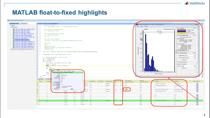Fixed-Point Made Easy for FPGA Programming
One of the biggest challenges in FPGA programming is the process of quantizing mathematical operations to fixed-point for more efficient implementation.
This session teaches the fundamentals of the fixed-point number system and fixed-point arithmetic, along with considerations for targeting popular FPGA devices. These concepts are then reinforced through practical demonstrations, capped by walking through the process of quantizing a signal processing design.
Topics include:
- Fixed-point theory
- Fixed-point number system
- Mathematical range
- Quantization error in the time and frequency domains
- Common functions
- Arithmetic: square root, reciprocal, log2
- Trigonometry: cosine, sine, atan2
- Signal processing: FIR, FFT
- FPGA considerations
- Targeting Xilinx and Intel devices
- Maintaining precision
- Using native floating point for full-precision calculations
- Example: communications packet detection
- Matched filter
- Peak detection
- FPGA optimizations
Published: 11 May 2020




